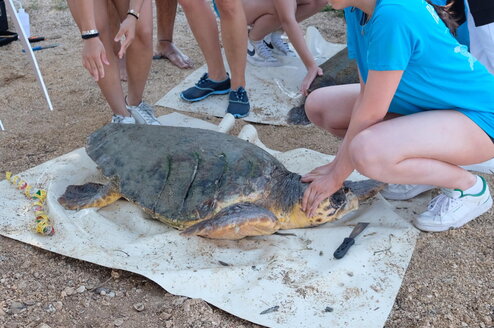High School Volunteer Abroad in Peru
High School Volunteer Abroad Programs in Peru
Pagination
About
Is lifeguarding at the pool just not what you had in mind for summer break? Would you prefer to spend your summer doing something more unique and adventurous? If you’re a high school student who enjoys community service, making new friends, travel, and being pushed outside your comfort zone, a volunteer program abroad may be a perfect way to spend your summer vacation.
If you’re also interested in community development, conservation, archaeology, or Spanish-language programs, Peru may be your ideal destination. Peru offers incredible ruins (hike Machu Picchu!), outdoor adventure (float the Amazon River or Lake Titicaca!), warm-hearted people, and a rich cultural heritage. It’s also a still developing nation with abundant opportunities to give back.
Photo Credit: Gabi Schiller
Program Types
As one of the most popular destinations for high school volunteer abroad programs, Peru offers plenty of different program types. Important factors to consider when choosing a volunteer program in Peru are: what types of projects most interest you, how long you’d like to volunteer, Spanish language requirements, physical labor required, accommodations (homestays vs. volunteer houses), and adventure/sightseeing trips. Taking the time to determine your “best fit” program will ensure a positive volunteer experience from the get-go. Popular program themes in Peru are:
Conservation Programs:Peru’s major environmental challenges include deforestation, air pollution, and soil erosion. High school volunteers in this type of program help build clean-burning stoves, greenhouses, and gardens in rural communities. In the Amazon River Basin, volunteers conduct trail maintenance, wildlife observations, and environmental research.
Community Development Programs: While Peru’s economy has made great improvements since the 1980s, most growth has not yet reached the rural, indigenous populations. High school volunteers can contribute in programs that provide construction and repairs, gardening and irrigation systems, medical outreach for women and children, education, and childcare to Peru’s disadvantaged communities.
Archaeology Programs: Peru was the center of the ancient Inca Empire, the largest empire in pre-Columbian America, and 5,000-year-old Caral-Supe (125 miles north of Lima) is considered the oldest center of civilization in the Americas. With world-famous sites like Machu Picchu, the Nazca lines, and ruins of the Sacred Valley of the Incas, Peru is a history buff’s dream. Interested high school students can volunteer alongside working archaeologists, helping to uncover and clear ruins throughout the Sacred Valley of the Incas.
Volunteer and Language Learning Programs: A few select volunteer programs offer high school students the opportunity to combine volunteerism with Spanish language learning. In these programs students spend half of their time in the classroom, earning up to three credits of college-level Spanish language courses. Courses are taken at a Peruvian university or private language school and students spend the second half of their trip completing volunteer projects.
Planning Your Trip
Nearly all high school volunteer trips to Peru take place over the summer (which coincides with Peru’s dry season and best weather) and last between two and four weeks. Most high school volunteer programs will be based out of Lima (Peru’s large capital city overlooking the Pacific Ocean), Cuzco (a UNESCO World Heritage Site known for its colonial architecture and tourism), the Sacred Valley of the Incas (quieter towns in the Andean highlands), or the Amazon River Basin (home to the world’s largest tropical rainforest).
Resources for Parents:
Because it has enjoyed a stable environment in recent years, Peru is a top destination for younger students. High school volunteers in Peru will travel in small groups, with most programs averaging a 7:1 student-to-staff ratio. Group leaders are experienced, English-speaking, and typically trained in First Aid and CPR. Each program also maintains its own medical contacts in country. Housing options vary but may include hotels, program-owned homes, or host families. Most programs offer parents a 24/7 support hotline. To stay healthy, students should visit a doctor at least four to six weeks before departing for Peru to receive vaccinations. Depending on the program location, your doctor may recommend vaccinations for Hepatitis A, Hepatitis B, Yellow Fever, Rabies, or Typhoid.
Financial Costs:
High school volunteer programs to Peru average between $1,300 and $1,600 per week. Always check the details of your program, but most program fees include accommodations and meals, medical and travel insurance, full-time staff support, coordination of volunteer projects, weekend excursions, and all in-country transportation. Most will not cover the cost of flights or passports. To help make volunteering abroad more affordable, students should research fundraising tips and scholarship opportunities.
Places to start are:
- Goennounce: Every month, Goennounce offers a $500 scholarship open to high school juniors and seniors and college freshmen and sophomores. Once you apply, share your educational goals online and you’ll be considered every month.
- LIVFund: LIVFund offers scholarships to students 18 and older interested in learning, interning, or volunteering abroad in Latin America. Winners are selected the first and third Monday of each month.
- And of course, Go Overseas’ own Volunteer Abroad Scholarship: Go Overseas awards scholarships of $500 to help fund your trip.














